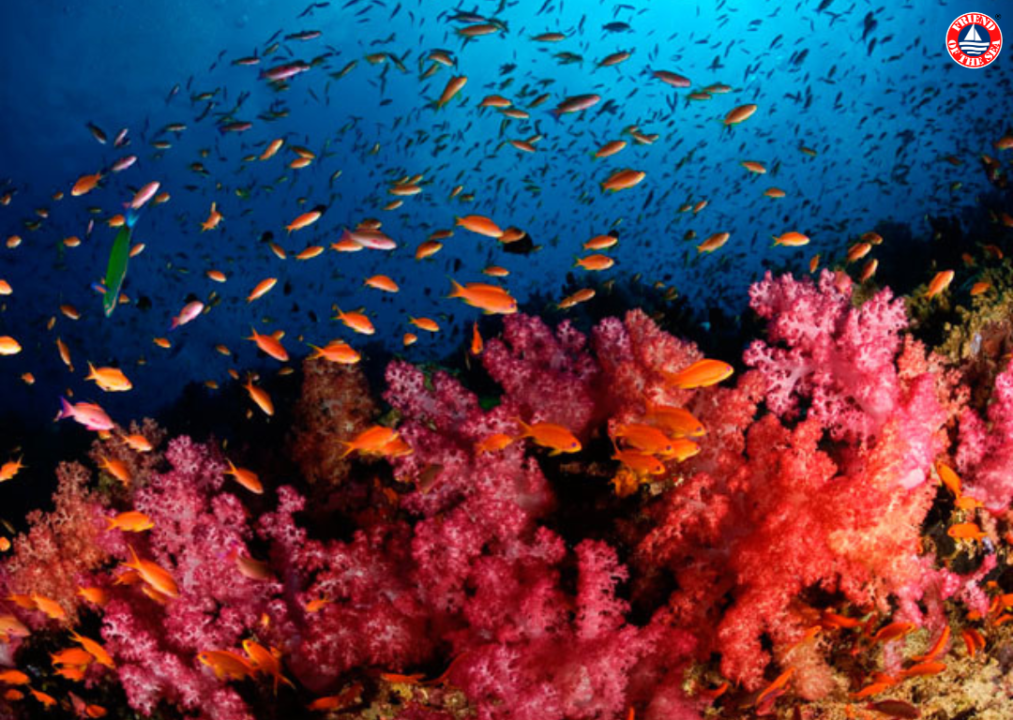To observe International Oceans Day on June 8, Friend of the Sea® takes you deep underwater, revealing interesting and unknown facts about coral reefs; a precious yet endangered ecosystem found on the seabed. Coral reefs are biodiversity treasures, distributed in intertropical areas where water temperatures are high enough for their existence. Consisting of corals and algae, they are home to various animals namely fish, seabirds, sponges, crustaceans, and sea turtles. Although they occupy only 0.3% of the Earth’s ocean floor, they support 25% of all marine species. Climate change, pollution, and human activity pose major threats to the survival of Coral Reefs; arguably the most delicate ecosystem. Friend of the Sea® as part of its Save the Corals project, is providing financial support to the Love Wildlife Foundation, Thailand. The foundation operates the Aow Thai Marine Ecology Center (ATMEC), for the reconstruction of a piece of coral reef on the island of Koh Mun Nai. ATMC seeks to provide education in marine biology and ecology to students of all ages, as well as conduct research for the conservation of corals in the Gulf of Thailand. As a result of support from Friend of the Sea®, ATMEC will restore part of Koh Mun Nai island’s coral reef. To learn more about this magical world on the seabed, or discover where to find the most extensive coral reefs in the world, read this in-depth Friend of the Sea® feature. Happy International Oceans Day! The World of Coral Reefs The thought of coral reefs brings to mind the image of an underwater world; rich in biodiversity, shapes, and a colorful habitat nestled at the bottom of tropical seas and oceans. Coral Reefs are a dynamic ecosystem, characterized by immeasurable biodiversity. These living structures are at the base of which there are animals similar to jellyfish upside down, called coral polyps, which mainly secrete calcium carbonate, which forms the rocky structure that we can see in documentaries or while diving in tropical waters. Among the corals, we can mention ‘’Madrepore’’, called ‘’hermatypic corals’’, or coral builders able to secrete and consolidate a solid calcareous skeleton capable of withstanding strong wave motion. Their existence is given by the presence of some particular algae, the ‘’ Zooxanthellae’’, and by a very close association between them, called ‘’symbiosis’’. Due to their strict dependence on algae, most of the corals cannot survive beyond certain depths as light cannot reach the algae, preventing the photosynthetic process and causing them to die, thereby blocking the formation of the calcareous skeleton. From this, we can understand that light has a fundamental role: it is in fact captured by algae, stimulating their growth. In addition, Zooxanthellae are also important for the survival of many species, because these algae secrete some sugars, important for colony growth. Coral reefs are home to a wide variety of animals: fish, seabirds, sponges, cnidarians (including some types of corals and jellyfish), worms, crustaceans (including shrimps, lobsters, and crabs), mollusks (including cephalopods), echinoderms (including starfish, sea urchins, and sea cucumbers), ascidians, sea turtles and sea snakes. Some species feed directly on corals, while others on algae. The same hiding places in a coral reef can be regularly inhabited by different species at different times of the day: you can find everything in these wonderful habitats! Where are Coral Reefs Found? The coral reefs are distributed in the intertropical areas, as, in order to exist, they need high water temperatures, which should never be lower than about 20 °C. As a result, the best areas are the areas of the Central Pacific and the Australian east coast, while the western coasts aren’t suitable due to the numerous cold currents. The main coral reefs in the world are: –The Australian Great Barrier Reef, which is located off the coast of Queensland and is the largest coral reef in the world: in fact, it consists of 3.000 systems of reefs and extends for about 2.300 Km! It has been a UNESCO World Heritage Site since 1981 –The Red Sea Coral Reef, in Egypt, which is located off the coast of Egypt, Israel and Saudi Arabia: 10% of the 1.200 species found in this coral reef are unique to this are –The Barrier Reef of New Caledonia, in the South Pacific, included in 2008 among the UNESCO World Heritage Site –The Mesoamerican Reef, in the Caribbean basin, that is the largest coral reef of the Atlantic Ocean: the coral reef extends almost 1.126 Km from Yucatan to the Bay of Islands, in Honduras. It is a UNESCO World Heritage Site since 1996 –The Maldives Coral Reef, in the Indian Ocean –The Apo Barrier Reef, in the Philippines, 800 Km long and covering 67,877 acres off the coast of the island of Mindoro, surrounded by a mangrove forest –The Belize Barrier Reef, in the Caribbean Sea, extended from Ambergris Caye in the north to the Sapodilla Cayes in the south (this coral reef is protected by the UNESCO program) Looming Threats Currently, this sensitive ecosystem is in danger and risks to disappear for many reasons. The main cause seems to be climate change and pollution: the ‘’bleaching’’, that is the coral’s whitening (phenomenon that consists in the expulsion of the Zooxanthellae from the tissues of the coral itself) is the consequence of a strong stress due to the heating of the surrounding waters, associated with the progressive change of the global climate and also the combined action of the massive anthropic activity. Coastal activities, deforestation of mangroves and rainforests are also a problem, as they lead to an excessive supply of sediment and nutrients in ocean waters, often accompanied by chemical pollution. Do not underestimate the bad habit of taking tropical corals in nature to make souvenirs. In addition, one of the problems of coral reefs is the time that corals take to recover from damage, in fact many of them grow a few centimeters a year. Some researchers have found a way to repair the reefs: corals to recreate must be attached to a solid substrate and must receive a continuous flow of water, in this way the researchers built small steel frames to which the fragments of live corals were attached: these steel frames, called ‘’stars of the coral reef’’, led to an increase in the coral’s growth. Fortunately, today there’re many associations and campaigns that deal with the preservation of these wonderful underwater worlds and their inhabitants. Among these, important is the commitment of Friend of the Sea® to the coral’s protection, with the project ‘’Save the Corals’’, and by promoting sustainable fishing and aquaculture practices through precise standards to be respected that limit the impact of fishing on coral reefs. In addition, another important project concerns the certification for suncream, in fact, many sunscreens damage the corals leading to infertility and bleaching. The Friend of the Sea Reef Safe Sunscreen certification standard certifies only sunscreens that do not contain substances toxic to corals and other marine creatures. 5 Fun Facts about Coral Reefs – Coral reefs occupy only 0.3% of the Earth’s ocean floor, but support 25% of all marine species on our planet – Coral reefs protect coasts more effectively from storm surges and tsunamis than any structure ever created by humans – A prediction of the future of this habitat comes from some Australian researchers, who predict the death of the Great Barrier Reef within 50 years due to the rise in average water temperatures (increases from 2 to 6 °C are expected) – Reef formation takes thousands of years and several million colonies to create relevant coral structures – Coral reefs are the habitat of over a quarter of the existing marine species, in fact the health of the fish is largely due to the presence and good condition of these underwater habitats: they host 4.000 species of fish, 700 species of corals and thousands of other plants and animals. Scientific Researchers have been studying solutions aimed at the protection of Coral Reefs, you too can support the conservation of Coral Reefs, by joining us at Friend of the Sea® on our mission to Save the Corals.




